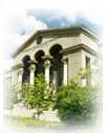| ENG RUS | Timus Online Judge |
Ural FU Open Personal Contest 2014
Contest is over
A. Crossroads of DestinyTime limit: 1.0 second Memory limit: 64 MB Winter in Yekaterinburg is the longest time of the year. And everyone
spends long winter evenings in his own way. A few days ago, Sergey found
Her on the Internet. She is the girl of his dreams! Today he has invited
Her on a date at a small cozy cafe on the crossroads of Marx street and
Engels street. Now Sergey goes to the cafe and he seems to be late. Sergey goes along
Marx street, crosses it through a crosswalk, reaches the crossroads with
Engels street, crosses it at traffic light and enters the cafe. There is
no one inside — She has already gone. However, Sergey thinks not about
catching up with her, but whether it was necessary to cross Marx street
through the crosswalk. After all, he could reach the crossroads and cross
both streets at the traffic light. And who knows, maybe in this case he
would not have lost time in waiting for the green traffic light signal and
could come in time. Which of these options is faster depends entirely on
what point in time the right signal will light. To predict it in advance
is impossible, but it is possible to estimate the probability. Sergey always walks with a constant speed v and strictly follows the
traffic rules. So he starts to cross a street at the traffic light only
when there is the green signal for him, but not yellow and especially not
red. Starting to cross a street, Sergey do it with the same constant speed
and without stops, regardless of the traffic light color change. The
traffic light at the crossroads of Marx street and Engels street works
as follows. For t1 seconds, there is a green signal for pedestrians
crossing Engels street, and red signal for crossing Marx street. Then for
t2 seconds there is a yellow signal for crossing Engels street and red
signal for crossing Marx street. Then for t3 seconds there is a green
signal for crossing Marx street and red signal for crossing Engels street.
Then for t4 seconds there is a yellow signal for crossing Marx street
and red signal for crossing Engels street. Then everything is repeated. InputThe first line contains an integer v that is the speed of Sergey (1
≤ v ≤ 106). The second line contains integers d, w1
and w2 that are the distance between the crosswalk and the crossroads,
the width of Engels street and the width of Marx street respectively OutputOutput two numbers — the probability that at the equiprobable initial
state of the traffic light Sergey would reach the cafe faster, crossing
Marx street at the crosswalk, and the probability that he would reach
faster, crossing both streets at the crossroads. Absolute error of your
answer should not exceed 10−9. Sample
Problem Author: Egor Shchelkonogov Problem Source: Open Ural FU Personal Contest 2014 |
